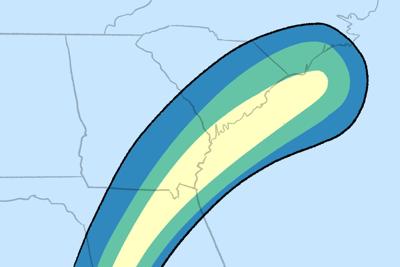Hurricane Idalia hit portions of southeast and south central Georgia on Aug. 30. Gov. Brian Kemp issued a state of emergency for all of Georgia in preparation for the storm the day before. The order took effect on Aug. 29 and lifted on Sept. 8.
The storm reached 90 mph when hitting Valdosta, Georgia, that morning, making it a Category 1 storm, according to Kemp It reached South Carolina by 8 p.m., leaving one Georgia man dead and approximately 190,000 Georgians without power.
The storm did, however, spare much of the state. Category 1 is the lowest of five classifications on the Saffir Simpson Hurricane Wind Scale, which defines it as dangerous winds with the potential to cause some damage. However, are hurricanes something that students in Georgia should begin to worry about?
As a state that borders the coast, Georgia can be affected by hurricanes that originate in the southern Atlantic Ocean, Caribbean Sea and Gulf of Mexico. Focusing on where tropical cyclones begin can thus help Georgians decipher whether or not an impending storm is one to keep an eye on.
Another consideration would be the impact of global warming on the frequency and severity of hurricanes. There is strong scientific evidence that suggests humans have contributed between 0.8-1.3 degrees Celsius to global mean temperature since the late 1800s.
This warming leads scientists to project an increase in tropical cyclone rainfall rates and tropical cyclone intensities, which means that destructive potential per storm will also increase. The global proportion of cyclones that will reach intense levels, such as in Categories 4 and 5, is also projected to increase. Higher water temperature has already begun to cause slower-moving, higher-category storms.
Dr. James Marshall Shepherd, the Georgia Athletic Association Distinguished Professor and Director of the University of Georgia’s Atmospheric Sciences Program, researches hurricanes with a focus on rainfall related to each class of hurricane.
“The best literature right now suggests that there is more likely to be an impact on the intensity of the storms in terms of their strength,” Shepherd said.
Shepherd says that this strength can be seen through the billions of dollars of damage to agricultural crops and facilities in south Georgia during Hurricane Michael, which occurred in 2018. Shepherd’s involvement in IRIS, the Institute for Resilient Infrastructure Systems, has allowed him to see some improvements in terms of protections for these types of storms.
“We’re helping government officials think about ways that they can better increase resiliency to storms,” Shepherd said. “And some of those actually include not just sort of typical engineering resilience, but also what we call nature based engineering or engineering with nature.”
Shepherd said nature based engineering includes using oyster shells on reefs. In some locations, oyster reefs can protect underwater vegetation and provide additional resilience against wave action, according to the National Marine Fisheries Service Fisheries.
Caroline Kraeuter, a second-year from Savannah, Georgia, knew that Hurricane Idalia was coming. She kept up with its status as it made its way towards the coast.
“It looked like for a second it was going to hit us at a Category 2, which isn’t ideal,” Kraueter said. “One of the worst [hurricanes] we had … was a one, and it really messed up Savannah. So normally, I think with that history they would have evacuated, but I think it was too late.”
If the city had let the residents in the area know earlier, they may have evacuated. That did not end up being necessary, as the flooding in that area was fairly minor. Still, Kraeuter believes that members of her community are growing tired of having to take their own precautions against hurricanes.
“People are kind of tired of doing stuff,” Kraeuter said. “Like every year they do less and less to prepare.”
Shepherd claims he was shocked by the abnormality of the strength of Hurricane Idalia.
“It was bizarre to me that there was actually still a hurricane warning in Valdosta,” Shepherd said. “That’s just something you don’t normally see.”
Shepherd believes that now local, state and federal officials are finally coming to understand the increasing severity of hurricanes in Georgia.


